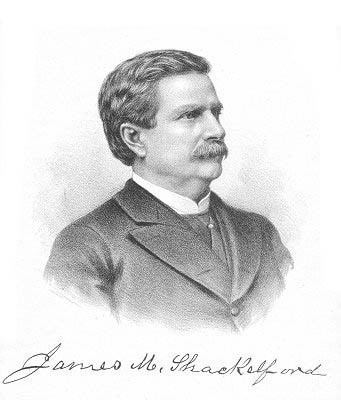Other work lawyer, judge | Name James Shackelford | |
 | ||
Born July 7, 1827Lincoln County, Kentucky ( 1827-07-07 ) Battles/wars Mexican WarAmerican Civil WarBattle of Fort DonelsonBattle of Buffington IslandBattle of New LisbonBattle of the Cumberland GapBattle of BlountvilleBattle of Campbell's StationSiege of KnoxvilleBattle of Bean's Station Commands held 25th Regiment Kentucky Volunteer Infantry Similar People John Hunt Morgan, James Longstreet, John Parke, Earl Cranston | ||
Years of service 1847-1848, 1861-1864 | ||
James Murrell Shackelford (July 7, 1827 – September 7, 1907) was a lawyer, judge, and general in the Union Army during the American Civil War. He has the distinction of having captured Confederate cavalry commander John Hunt Morgan in mid-1863, effectively ending "Morgan's Raid".
Contents
Early life
Shackelford was born in Kentucky in 1827 to a family with roots in Tidewater Virginia in the 17th century. As a young age, Shackelford joined a regiment of Kentucky volunteers as a second lieutenant in time for the Mexican War. The fighting had subsided by the time the regiment reached Mexico, but Shackelford's soldierly conduct won him a promotion to first lieutenant.
He returned to Kentucky and began studying law at the office of a local judge and was admitted to the bar in 1851. His legal career grew in prominence until interrupted by the Civil War.
Civil War service
Shackelford was appointed colonel of the 25th Kentucky Infantry on January 1, 1862. His regiment joined Lew Wallace's division during the Battle of Fort Donelson. Exposure to the elements at Fort Donelson forced Shackelford to resign on March 24, 1862, on account of poor health. During his convalescence, Shackelford helped recruit another regiment of Kentucky volunteers which was mustered in as the 8th Kentucky Cavalry with Shackelford as colonel. A few months later, on January 1, 1863, he was promoted to Brigadier General of Volunteers and assigned to command the 1st Brigade, 2nd Division, XXIII Corps.
In July of that year, Shackelford took part in Edward Hobson's expedition in pursuit of the noted Confederate raider, John Hunt Morgan. Union forces caught up with Morgan at the Battle of Buffington Island in southern Ohio. Half of the Confederate force surrendered but nearly 400, including Morgan escaped along the north bank of the Ohio River. Shackelford's brigade finally cut off Morgan's remaining force at the Battle of Salineville in northeastern Ohio.
Later that year, as Ambrose E. Burnside marched toward Knoxville, Tennessee, he bypassed the Cumberland Gap, leaving a single brigade posted there. Burnside occupied Knoxville on September 1, 1863 and turned his attention back to the Cumberland Gap, dispatching Shackelford's brigade. Shackelford demanded that Confederate general John W. Frazer surrender the gap, but Frazer refused. Burnside personally arrived with reinforcements and forced the Confederates to surrender. Later in the month, Shackelford was promoted to command a division in the XXIII Corps and then in November to command of the Cavalry Corps in the Army of the Ohio. Shackelford's cavalry helped to secure the vital cross roads at the Battle of Campbell's Station and participated in the Siege of Knoxville. When James Longstreet's Confederate forces retreated from Knoxville, Shackelford was sent in pursuit. He caught up with the Confederates, but in the Battle of Bean's Station Longstreet checked the Union pursuit before withdrawing from the region.
Later life
On January 18, 1864, Shackelford unexpectedly resigned from the army on account of the death of his wife. He moved to Evansville, Indiana, and resumed his law practice. In 1889 President Benjamin Harrison appointed Shackelford U.S. judge in the Indian Territory, replacing Isaac C. Parker.
James Shackelford died in the fall of 1907 at his summer home in Port Huron, Michigan. He is interred in Cave Hill Cemetery in Louisville, Kentucky.
